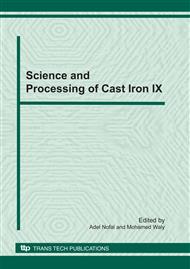p.151
p.157
p.163
p.169
p.175
p.181
p.187
p.193
p.199
Influence of Alloying Elements on the Bainitic Transformation of Ductile Iron
Abstract:
Alloying elements may be added to ductile iron to improve mechanical properties or prevent pearlitic transformation during austempering process. On the other hand, the segregation of alloying elements during solidification changes the kinetics of austempering process which in turn bainitic transformation would be function of local concentration of alloying elements. In this research, kinetics of the first stage of bainitic transformation in ductile iron has been studied by the means of comparing the bainitic transformation in steels with the same composition similar to the alloyed ductile iron matrix after austempering treatment. According to the results of dilatometry tests, the effect of Si and Mn in steel samples on the incubation time of bainitic transformation was obtained. Also, the influence of austempering temperature on "S-shape" curve has been investigated by means of dilatometry data.
Info:
Periodical:
Pages:
175-180
Citation:
Online since:
December 2010
Authors:
Keywords:
Price:
Сopyright:
© 2011 Trans Tech Publications Ltd. All Rights Reserved
Share:
Citation:


